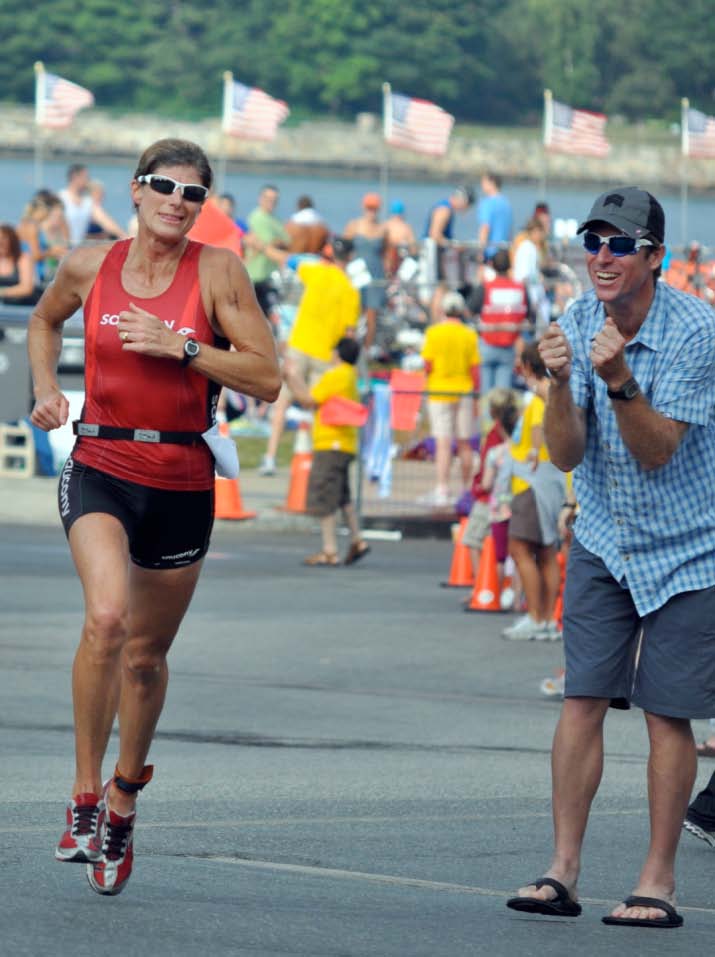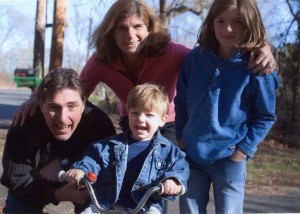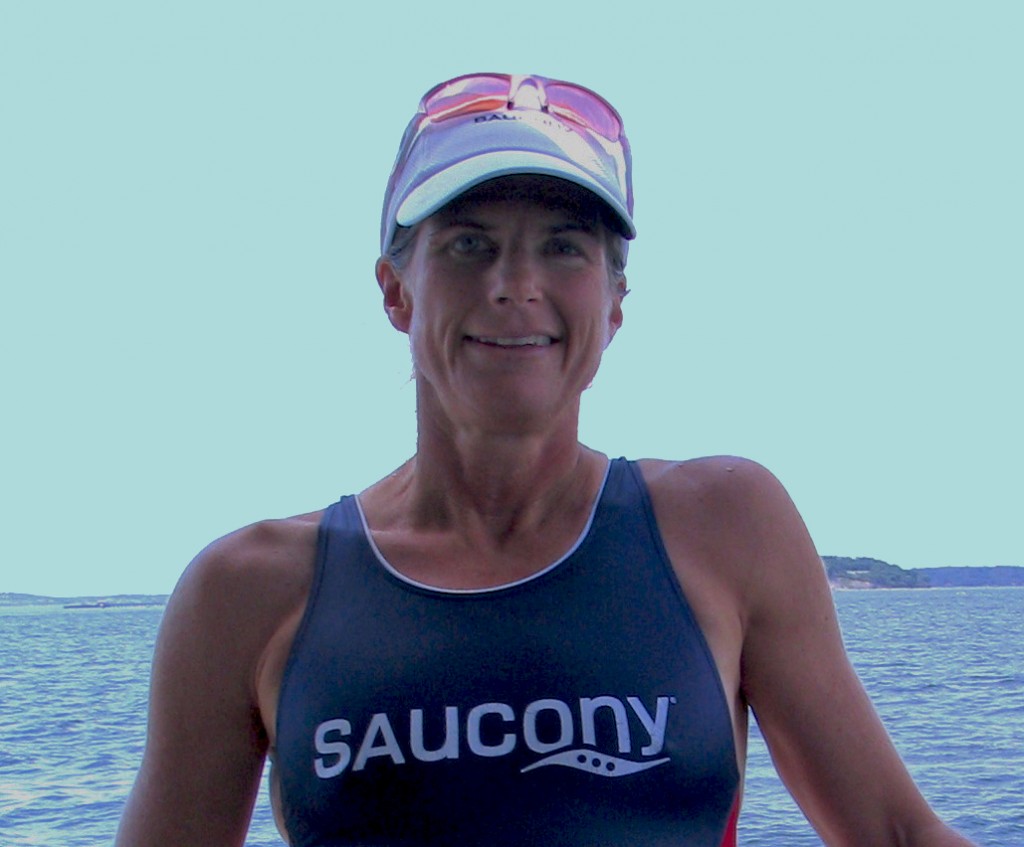
In a sport that rewards heavy training and routinely leads to mental and physical burnout, the professional triathlete has stuck with it while raising two kids in Lincoln, Mass., with her husband and coaching other athletes. She recently offered some tips on balancing exercise and the rest of life.

Did you have a grand strategic plan for your career that involved pro racing at age 49?
 Not at all. At first, I thought it was a hobby. At Princeton, I swam on the team and ran track. After college was the first time that I didn’t have an organized team, and I found I didn’t have an anchor without an athletic event in my life. A friend did triathlons, and we started training together. It was a lot of fun and a good way to meet people. In 1984, I was an amateur, but at one race I did well enough to have won $500 if I had entered as an elite, so in 1985 I started racing pro. In 1989, the computer company where I worked went bankrupt, and I started doing triathlon full time. I saw that with sponsors and prize money, I could make a living at it.
Not at all. At first, I thought it was a hobby. At Princeton, I swam on the team and ran track. After college was the first time that I didn’t have an organized team, and I found I didn’t have an anchor without an athletic event in my life. A friend did triathlons, and we started training together. It was a lot of fun and a good way to meet people. In 1984, I was an amateur, but at one race I did well enough to have won $500 if I had entered as an elite, so in 1985 I started racing pro. In 1989, the computer company where I worked went bankrupt, and I started doing triathlon full time. I saw that with sponsors and prize money, I could make a living at it.
Back then, I thought I was in the prime of my career!
How have you changed your training as you’ve gotten older?
I don’t want to do the same thing every year. There are certain workouts I need to do to get in Ironman shape, but I’m trying to find ways to change things so I don’t get stale and hit a plateau. I’ve added in strength training, which I never really did after college. All the research says you’ve really got to do that as you get older.
Has your diet changed over the years?
I try to eat foods as close to the source as possible, and base my meals around good healthy food and lots of fruits and veggies. But my overall diet philosophy is all things in moderation. Except for beer and chocolate-chip cookies. Those are in excess.
Any dietary advice for active folks?
I think it is important to get a balance at every meal; to make sure you get some protein and fat along with the carbohydrates that many athletes crave. For people who don’t have a lot of time to cook, I recommend adding fresh fruit or veggies to convenience food to enhance the nutritional value. You can add bananas and strawberries to your cereal, fresh broccoli to red sauce, or some peppers and tomatoes to bagged salads.
You’ve taken time off over the years to have kids and after a bout with thyroid cancer and a bike-vs.-18-wheeler crash. How did exercise help you bounce back?
Just a little walk was able to get me through many of my recoveries. After my two C-sections, walking helped my circulation and helped my digestive system get jump-started again. When recovering from my cancer surgeries, exercise helped me regain a sense of wellness and also confidence in my body. Cancer has a tendency to rob you of your feeling of control; seeing my body respond to exercise by getting stronger helped me regain that control. I wasn’t “training” per se, I was merely exercising—getting the body moving and the heart rate elevated for a period of time. It is so important and can be such a miracle cure.
Have you ever had an overuse injury?
I wish I knew back in college, when I was on the swim team, what I know now about recovery and overtraining. I’ve suffered from overtraining at times, but not since the late 1980s—knock on wood. I’ve had no stress fractures, for example. I’m really careful about not getting overtrained, and I’m a big believer in a minimalist program. I totally train by feel. I have things on my schedule that I’ve planned, but I’ll cut workouts short if I’m tired. I’ve developed my own instincts.
You also coach yourself. How do you make yourself keep your life in balance?
The Ironman buildup is a burden on the family. Long training is a grind for me, so I keep it to a pretty quick buildup so I won’t get sick of it. What matters is how much my body can absorb while still staying fresh and excited about it. And I definitely can’t fit in as much volume these days—not with two kids and coaching.
What’s your advice for midlife athletes who haven’t done sports all their lives?
It’s never too late to start. The 60-plus age groups at the Ironman are filled with men and women who didn’t even start running or biking until they were middle-aged. But start small and with something that you enjoy. Find a friend to walk with; join an adult soccer or volleyball league. Sign up for classes at the gym. If you can combine a social element with the exercise component, you’re more likely to enjoy it and stick with it. The great thing about just starting out is that you get to see improvement very quickly. If you stick with it, you can feel yourself be transformed.
Do you think you’ll retire from racing?
I don’t see the word “retire” connected with my life!
NOT EVEN A DAY OF REST
Think your workout regimen is tough? Here’s how 49-year-old professional triathlete Karen Smyers spends a typical hard training week:
Monday: About an hour of swimming in the morning, then an “easy” bike ride of between 45 minutes and 2 hours (she may skip it if she feels tired or time-pressed).
Tuesday: A 1 1/2-to-2-hour bike ride that includes either hill repeats (riding the same hill over and over) or intervals (shorter bursts of speed followed by a recovery period) to add intensity. Later in the day, a running workout on the track, which builds over time from 2 1/2 miles to 4 miles of intervals.
Wednesday: About an hour of swimming in the morning (which Smyers might skip if she’s going to swim on Thursday and Friday), then an easy bike ride.
Thursday: Long “brick” day with intense back-to-back workouts: first a 3-hour bike ride, followed immediately by a 60-to-90-minute run. And maybe a 2-mile-plus open-water swim at Walden Pond.
Friday: As much as 90 minutes of swimming in the morning, then an easy bike ride if she has time.
Saturday: A long bike ride of up to 130 miles followed immediately by a 3-mile “transition” run to reacquaint her legs with running.
Sunday: A long run of 15 to 20 miles.
article by Katherine Hobson
She’s Always on the Move
US News and World Report